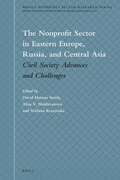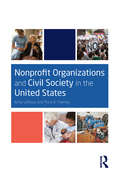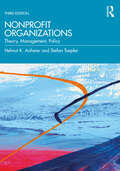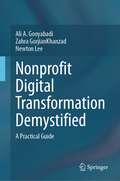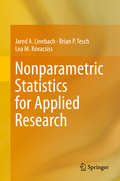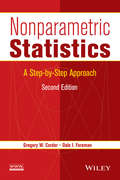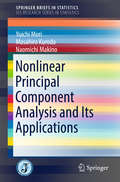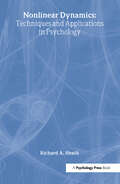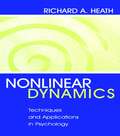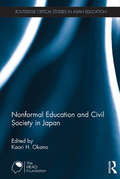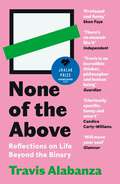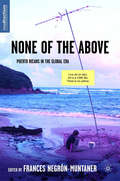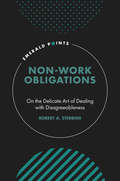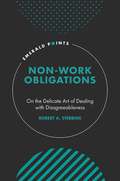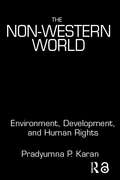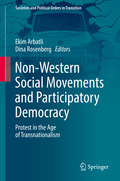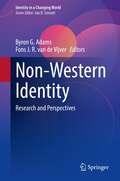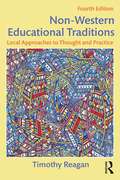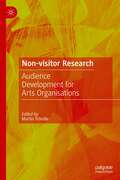- Table View
- List View
The Nonprofit Sector In Eastern Europe, Russia, And Central Asia: Civil Society Advances And Challenges (Brill's Nonprofit Sector Research Ser. (PDF) #1)
by David Horton Smith Alisa Moldavanova Svitlana Krasynska<i>The Nonprofit Sector in Eastern Europe, Russia, and Central Asia (EERCA)</i>, edited by David Horton Smith, Alisa V. Moldavanova, and Svitlana Krasynska, uniquely provides a research overview of the nonprofit sector and nonprofit organizations in eleven former Soviet republics, with each central chapter written by local experts. Such chapters, with our editorial introductions, present up-to-date versions of works previously published in EERCA native languages. With a Foreword by Susan Rose-Ackerman (Yale University), introductory and concluding chapters also explain the editors’ theoretical approach, setting the whole volume in several, relevant, larger intellectual contexts, and summarize briefly the gist of the book. The many post-Soviet countries show much variety in their current situation, ranging from democratic to totalitarian regimes.
Nonprofit Organizations and Civil Society in the United States
by Kelly LeRoux Mary K. FeeneyLeRoux and Feeney’s Nonprofit Organizations and Civil Society in the United States makes a departure from existing nonprofit texts on the market: rather than focus on management, it focuses on nonprofit organizations and their contributions to the social, political, and economic dimensions of society. The book also covers the nexus between nonprofits and civil society. This text offers a theory-oriented undergraduate introduction to the nonprofit field and an examination of the multifaceted roles these organizations play in American society.
Nonprofit Organizations and Civil Society in the United States
by Kelly LeRoux Mary K. FeeneyLeRoux and Feeney’s Nonprofit Organizations and Civil Society in the United States makes a departure from existing nonprofit texts on the market: rather than focus on management, it focuses on nonprofit organizations and their contributions to the social, political, and economic dimensions of society. The book also covers the nexus between nonprofits and civil society. This text offers a theory-oriented undergraduate introduction to the nonprofit field and an examination of the multifaceted roles these organizations play in American society.
Nonprofit Organizations: Theory, Management, Policy
by Helmut K. Anheier Stefan ToeplerIn this new edition of the popular textbook, Nonprofit Organizations: Theory, Management, Policy, Helmut K. Anheier and Stefan Toepler have fully updated, revised, and expanded this comprehensive introduction to a growing field. The text takes on an international and comparative perspective, detailing the background and concepts and examining relevant theories and central issues. Anheier and Toepler cover the full range of nonprofit organizations—service providers, membership organizations, foundations, community groups—in different fields, such as arts and culture, health and social services, and education. Introducing central terms such as philanthropy, charity, social entrepreneurship, social investment, and civil society, they explain how the field relates to public management and administration. This textbook is systematic in its approach to theories, management, and policy. The first edition won the Best Book Award at the American Academy of Management in 2006, and this new edition will continue to match the growing demand for academic teaching. Nonprofit Organizations: Theory, Management, Policy is an ideal resource for students of both undergraduate and postgraduate courses.
Nonprofit Organizations: Theory, Management, Policy
by Helmut K. Anheier Stefan ToeplerIn this new edition of the popular textbook, Nonprofit Organizations: Theory, Management, Policy, Helmut K. Anheier and Stefan Toepler have fully updated, revised, and expanded this comprehensive introduction to a growing field. The text takes on an international and comparative perspective, detailing the background and concepts and examining relevant theories and central issues. Anheier and Toepler cover the full range of nonprofit organizations—service providers, membership organizations, foundations, community groups—in different fields, such as arts and culture, health and social services, and education. Introducing central terms such as philanthropy, charity, social entrepreneurship, social investment, and civil society, they explain how the field relates to public management and administration. This textbook is systematic in its approach to theories, management, and policy. The first edition won the Best Book Award at the American Academy of Management in 2006, and this new edition will continue to match the growing demand for academic teaching. Nonprofit Organizations: Theory, Management, Policy is an ideal resource for students of both undergraduate and postgraduate courses.
Nonprofit Digital Transformation Demystified: A Practical Guide
by Ali A. Gooyabadi Zahra GorjianKhanzad Newton LeeIn this compelling journey into Digital Transformation (DT) tailored for Nonprofit Organizations (NPOs), this book unravels the intricacies of technological integration. Grounded in over one hundred years of extensive research by authors and the editor, real-world examples, and using the San Diego Diplomacy Council (SDDC) as a primary case study, it introduces a tailored Digital Maturity Model (DMM) for NPOs. At the heart of this transformation are three pivotal pillars: Culture, Ethics, and Security.Part I sets the stage, painting a landscape of how NPOs have intertwined with the digital realm. As technology's omnipresence surges, Chapter Two offers a panorama of DT's historical and contemporary intersections with the nonprofit sector. The subsequent chapter emphasizes the stark reality: for many NPOs, digital adaptation is no longer about relevance but survival.Part II delves into the comparative digital strategies of NPOs and their for-profit counterparts in Chapter 4, highlighting the need for tailored approaches. Chapter 5 explores the Nonprofit Digital Maturity Model (NDMM), using the San Diego Diplomacy Council as a focal point. The journey then unfolds further in Chapter 6, which casts a spotlight on the strategic execution of DT in NPOs, weaving in comprehensive analyses to dissect the forces shaping an NPO's digital trajectory.Part III dives deeper, with Chapter 7 laying the foundation of the NDMM. The subsequent chapter meticulously unpacks the NDMM, culminating in Chapter 9, which emphasizes the pillars of DT—Culture, Ethics, and Security—forming the essence of the Nonprofit DT Strategic Framework (NDTSF). This chapter also crafts a tailored roadmap for NPOs, charting a comprehensive DT course.Concluding with a forward-looking stance, Chapter 10 thrusts readers into the enthralling fusion of AI and NPOs, exploring transformative potentials and ethical concerns. Through real-world cases, it positions AI as both a potent tool and a vital dialogue for NPOs. Essentially, this book equips NPOs with tools like the NDMM and insights from successful DT narratives. It seeks to provide a practical guide for nonprofits through their DT journey, ensuring they harness technology ethically and effectively without compromising their core values.
Nonparametric Statistics for Applied Research
by Jared A. Linebach Brian P. Tesch Lea M. KovacsissNon-parametric methods are widely used for studying populations that take on a ranked order (such as movie reviews receiving one to four stars). The use of non-parametric methods may be necessary when data have a ranking but no clear numerical interpretation, such as when assessing preferences. In terms of levels of measurement, non-parametric methods result in "ordinal" data. As non-parametric methods make fewer assumptions, their applicability is much wider than the corresponding parametric methods. In particular, they may be applied in situations where less is known about the application in question. Also, due to the reliance on fewer assumptions, non-parametric methods are more robust. Non-parametric methods have many popular applications, and are widely used in research in the fields of the behavioral sciences and biomedicine. This is a textbook on non-parametric statistics for applied research. The authors propose to use a realistic yet mostly fictional situation and series of dialogues to illustrate in detail the statistical processes required to complete data analysis. This book draws on a readers existing elementary knowledge of statistical analyses to broaden his/her research capabilities. The material within the book is covered in such a way that someone with a very limited knowledge of statistics would be able to read and understand the concepts detailed in the text.The “real world” scenario to be presented involves a multidisciplinary team of behavioral, medical, crime analysis, and policy analysis professionals work together to answer specific empirical questions regarding real-world applied problems. The reader is introduced to the team and the data set, and through the course of the text follows the team as they progress through the decision making process of narrowing the data and the research questions to answer the applied problem. In this way, abstract statistical concepts are translated into concrete and specific language.This text uses one data set from which all examples are taken. This is radically different from other statistics books which provide a varied array of examples and data sets. Using only one data set facilitates reader-directed teaching and learning by providing multiple research questions which are integrated rather than using disparate examples and completely unrelated research questions and data.
Nonparametric Statistics: A Step-by-Step Approach
by Gregory W. Corder Dale I. Foreman“…a very useful resource for courses in nonparametric statistics in which the emphasis is on applications rather than on theory. It also deserves a place in libraries of all institutions where introductory statistics courses are taught." –CHOICE This Second Edition presents a practical and understandable approach that enhances and expands the statistical toolset for readers. This book includes: New coverage of the sign test and the Kolmogorov-Smirnov two-sample test in an effort to offer a logical and natural progression to statistical power SPSS® (Version 21) software and updated screen captures to demonstrate how to perform and recognize the steps in the various procedures Data sets and odd-numbered solutions provided in an appendix, and tables of critical values Supplementary material to aid in reader comprehension, which includes: narrated videos and screen animations with step-by-step instructions on how to follow the tests using SPSS; online decision trees to help users determine the needed type of statistical test; and additional solutions not found within the book.
Nonparametric Statistics: A Step-by-Step Approach
by Gregory W. Corder Dale I. Foreman“…a very useful resource for courses in nonparametric statistics in which the emphasis is on applications rather than on theory. It also deserves a place in libraries of all institutions where introductory statistics courses are taught." –CHOICE This Second Edition presents a practical and understandable approach that enhances and expands the statistical toolset for readers. This book includes: New coverage of the sign test and the Kolmogorov-Smirnov two-sample test in an effort to offer a logical and natural progression to statistical power SPSS® (Version 21) software and updated screen captures to demonstrate how to perform and recognize the steps in the various procedures Data sets and odd-numbered solutions provided in an appendix, and tables of critical values Supplementary material to aid in reader comprehension, which includes: narrated videos and screen animations with step-by-step instructions on how to follow the tests using SPSS; online decision trees to help users determine the needed type of statistical test; and additional solutions not found within the book.
Nonlinear Principal Component Analysis and Its Applications (SpringerBriefs in Statistics #0)
by Yuichi Mori Masahiro Kuroda Naomichi MakinoThis book expounds the principle and related applications of nonlinear principal component analysis (PCA), which is useful method to analyze mixed measurement levels data. In the part dealing with the principle, after a brief introduction of ordinary PCA, a PCA for categorical data (nominal and ordinal) is introduced as nonlinear PCA, in which an optimal scaling technique is used to quantify the categorical variables. The alternating least squares (ALS) is the main algorithm in the method. Multiple correspondence analysis (MCA), a special case of nonlinear PCA, is also introduced. All formulations in these methods are integrated in the same manner as matrix operations. Because any measurement levels data can be treated consistently as numerical data and ALS is a very powerful tool for estimations, the methods can be utilized in a variety of fields such as biometrics, econometrics, psychometrics, and sociology. In the applications part of the book, four applications are introduced: variable selection for mixed measurement levels data, sparse MCA, joint dimension reduction and clustering methods for categorical data, and acceleration of ALS computation. The variable selection methods in PCA that originally were developed for numerical data can be applied to any types of measurement levels by using nonlinear PCA. Sparseness and joint dimension reduction and clustering for nonlinear data, the results of recent studies, are extensions obtained by the same matrix operations in nonlinear PCA. Finally, an acceleration algorithm is proposed to reduce the problem of computational cost in the ALS iteration in nonlinear multivariate methods. This book thus presents the usefulness of nonlinear PCA which can be applied to different measurement levels data in diverse fields. As well, it covers the latest topics including the extension of the traditional statistical method, newly proposed nonlinear methods, and computational efficiency in the methods.
Nonlinear Dynamics: Techniques and Applications in Psychology
by Richard A. HeathAdditional Resource Materials Human behavior would not be interesting to us if it remained the same from one moment to the next. Moreover, we tend to be sensitive to changes in people's behavior, especially when such change impacts on our own, and other's, behavior. This book describes a variety of techniques for investigating change in behavior. It employs conventional time series methods, as well as recently developed methodology using nonlinear dynamics, including chaos, a term that is not easy to define, nor to confirm. Although nonlinear methods are being used more frequently in psychology, a comprehensive coverage of methods, theory and applications, with a particular focus on human behavior, is needed. Between these covers, the reader is led through various procedures for linear and nonlinear time series analysis, including some novel procedures that allow subtle temporal aspects of human cognition to be detected. Analyses of reaction times, heart-rate, psychomotor skill, decision making, and EEG are supplemented by a contemporary review of recent dynamical research in developmental psychology, psychopathology, and human cognitive processes. A consideration of nonlinear dynamics assists our understanding of deep issues such as: Why is our short-term memory capacity limited? Why do chronic disorders, and also cognitive development, progress through stage-like transitions? Why do people make irrational decisions? This book will be of particular interest to researchers, practitioners, and advanced students in a variety of areas in psychology, particularly in human experimental and physiological psychology. Data analyses are performed using the latest nonlinear dynamics computer packages. A comprehensive WWW resource of software and supplementary information is provided to assist the reader's understanding of the novel, and potentially revolutionary, procedures described in the book.
Nonlinear Dynamics: Techniques and Applications in Psychology
by Richard A. HeathAdditional Resource Materials Human behavior would not be interesting to us if it remained the same from one moment to the next. Moreover, we tend to be sensitive to changes in people's behavior, especially when such change impacts on our own, and other's, behavior. This book describes a variety of techniques for investigating change in behavior. It employs conventional time series methods, as well as recently developed methodology using nonlinear dynamics, including chaos, a term that is not easy to define, nor to confirm. Although nonlinear methods are being used more frequently in psychology, a comprehensive coverage of methods, theory and applications, with a particular focus on human behavior, is needed. Between these covers, the reader is led through various procedures for linear and nonlinear time series analysis, including some novel procedures that allow subtle temporal aspects of human cognition to be detected. Analyses of reaction times, heart-rate, psychomotor skill, decision making, and EEG are supplemented by a contemporary review of recent dynamical research in developmental psychology, psychopathology, and human cognitive processes. A consideration of nonlinear dynamics assists our understanding of deep issues such as: Why is our short-term memory capacity limited? Why do chronic disorders, and also cognitive development, progress through stage-like transitions? Why do people make irrational decisions? This book will be of particular interest to researchers, practitioners, and advanced students in a variety of areas in psychology, particularly in human experimental and physiological psychology. Data analyses are performed using the latest nonlinear dynamics computer packages. A comprehensive WWW resource of software and supplementary information is provided to assist the reader's understanding of the novel, and potentially revolutionary, procedures described in the book.
Nonformal Education and Civil Society in Japan (Routledge Critical Studies in Asian Education)
by Kaori H. OkanoNonformal Education and Civil Society in Japan critically examines an aspect of education that has received little attention to date: intentional teaching and learning activities that occur outside formal schooling. In the last two decades nonformal education has rapidly increased in extent and significance. This is because individual needs for education have become so diverse and rapidly changing that formal education alone is unable to satisfy them. Increasingly diverse demands on education resulted from a combination of transnational migration, heightened human rights awareness, the aging population, and competition in the globalised labour market. Some in the private sector saw this situation as a business opportunity. Others in the civil society volunteered to assist the vulnerable. The rise in nonformal education has also been facilitated by national policy developments since the 1990s. Drawing on case studies, this book illuminates a diverse range of nonformal education activities; and suggests that the nature of the relationship between nonformal education and mainstream schooling has changed. Not only have the two sectors become more interdependent, but the formal education sector increasingly acknowledges nonformal education’s important and necessary roles. These changes signal a significant departure from the past in the overall functioning of Japanese education. The case studies include: neighbourhood homework clubs for migrant children, community-based literacy classes, after-school care programs, sport clubs, alternative schools for long-term absent students, schools for foreigners, training in intercultural competence at universities and corporations, kôminkan (community halls), and lifelong learning for the seniors. This book will appeal to both scholars of Japanese Studies/Asian Studies, and those of comparative education and sociology/anthropology of education.
Nonformal Education and Civil Society in Japan (Routledge Critical Studies in Asian Education)
by Kaori H. OkanoNonformal Education and Civil Society in Japan critically examines an aspect of education that has received little attention to date: intentional teaching and learning activities that occur outside formal schooling. In the last two decades nonformal education has rapidly increased in extent and significance. This is because individual needs for education have become so diverse and rapidly changing that formal education alone is unable to satisfy them. Increasingly diverse demands on education resulted from a combination of transnational migration, heightened human rights awareness, the aging population, and competition in the globalised labour market. Some in the private sector saw this situation as a business opportunity. Others in the civil society volunteered to assist the vulnerable. The rise in nonformal education has also been facilitated by national policy developments since the 1990s. Drawing on case studies, this book illuminates a diverse range of nonformal education activities; and suggests that the nature of the relationship between nonformal education and mainstream schooling has changed. Not only have the two sectors become more interdependent, but the formal education sector increasingly acknowledges nonformal education’s important and necessary roles. These changes signal a significant departure from the past in the overall functioning of Japanese education. The case studies include: neighbourhood homework clubs for migrant children, community-based literacy classes, after-school care programs, sport clubs, alternative schools for long-term absent students, schools for foreigners, training in intercultural competence at universities and corporations, kôminkan (community halls), and lifelong learning for the seniors. This book will appeal to both scholars of Japanese Studies/Asian Studies, and those of comparative education and sociology/anthropology of education.
None of the Above: Reflections on Life Beyond the Binary
by Travis AlabanzaWINNER OF THE SOMERSET MAUGHAM AWARD 2023 WINNER OF THE JHALAK PRIZE 2023 SHORTLISTED FOR THE POLARI FIRST BOOK PRIZE 2023 A WATERSTONES BEST BOOK OF 2022: POLITICS ‘A breath of fresh air . . . There's no memoir like it’ Independent ‘Travis Alabanza writes with such generosity and ease even the most provocative suggestions start to seem obvious . . . Profound and funny’ SHON FAYE ‘Will challenge, empower and move your soul’ Glamour ‘Lucid and glorious’ YRSA DALEY-WARD ‘A gloriously specific, funny and smart body of work’ CANDICE CARTY-WILLIAMS __________ ‘When you are someone that falls outside of categories in so many ways, a lot of things are said to you. And I have had a lot of things said to me.’ In None of the Above, Travis Alabanza examines seven phrases people have directed at them about their gender identity. These phrases have stayed with them over the years. Some are deceptively innocuous, some deliberately loaded or offensive, some celebratory; sentences that have impacted them for better and for worse; sentences that speak to the broader issues raised by a world that insists that gender must be a binary. Through these seven phrases, which include some of their most transformative experiences as a Black, mixed race, non binary person, Travis Alabanza turns a mirror back on society, giving us reason to question the very framework in which we live and the ways we treat each other.
None of the Above: Puerto Ricans in the Global Era (New Directions in Latino American Cultures)
by Frances Negrón-MuntanerThis volume sets out current debates about Puerto Rico. The title simultaneously refers to the results of a non-binding 1998 plebiscite held in San Juan to determine Puerto Rico's political status, the ambiguities that have historically characterized its political agency, and the complexities of its ethnic, national, and cultural identifications.
Non-Work Obligations: On the Delicate Art of Dealing with Disagreeableness (Emerald Points)
by Robert A. StebbinsThe world of non-work obligations - defined as disagreeable activities that are neither work nor leisure - is a territory of social life that has largely been ignored by scholars of work and leisure alike. The exception to this rule is Robert A. Stebbins, who over the years has written extensively on the significance of non-work obligations and the mundane and often disagreeable tasks that we are all compelled to face in our daily lives. In this new book, Stebbins brings together years of writing and research on this topic to forcefully argue that the current research interest in work-life balance can no longer afford to ignore the effects that non-work obligation has on it. He contends that, whether we like it or not, non-work obligations bear heavily on both our work and leisure. Having to deal with disagreeable tasks and objectionable people on a daily basis, without the support of any outside agency, can seriously undermine our well-being, and it is only through recourse to voluntary simplicity that we can hope to limit the harmful impact of non-work obligations. Written both as a guide to happy living and as a powerful rejoinder to conventional orthodoxy in the fields of leisure and work studies, the book is essential reading for both the general reader and scholars of leisure, consumer, work and happiness studies.
Non-Work Obligations: On the Delicate Art of Dealing with Disagreeableness (Emerald Points)
by Robert A. StebbinsThe world of non-work obligations - defined as disagreeable activities that are neither work nor leisure - is a territory of social life that has largely been ignored by scholars of work and leisure alike. The exception to this rule is Robert A. Stebbins, who over the years has written extensively on the significance of non-work obligations and the mundane and often disagreeable tasks that we are all compelled to face in our daily lives. In this new book, Stebbins brings together years of writing and research on this topic to forcefully argue that the current research interest in work-life balance can no longer afford to ignore the effects that non-work obligation has on it. He contends that, whether we like it or not, non-work obligations bear heavily on both our work and leisure. Having to deal with disagreeable tasks and objectionable people on a daily basis, without the support of any outside agency, can seriously undermine our well-being, and it is only through recourse to voluntary simplicity that we can hope to limit the harmful impact of non-work obligations. Written both as a guide to happy living and as a powerful rejoinder to conventional orthodoxy in the fields of leisure and work studies, the book is essential reading for both the general reader and scholars of leisure, consumer, work and happiness studies.
The Non-Western World: Environment, Development and Human Rights
by Pradyumna P. KaranThrough a cross-cultural and multi-disciplinary approach, this introductory textbook focuses on critical issues of development, environment, and cultural conflicts facing most area of the non-Western world. Areas covered include China, Japan, Southeast Asia, the Indian subcontinent, the Middle East, and sub-Saharan Africa.
The Non-Western World: Environment, Development and Human Rights
by Pradyumna P. KaranThrough a cross-cultural and multi-disciplinary approach, this introductory textbook focuses on critical issues of development, environment, and cultural conflicts facing most area of the non-Western world. Areas covered include China, Japan, Southeast Asia, the Indian subcontinent, the Middle East, and sub-Saharan Africa.
Non-Western Social Movements and Participatory Democracy: Protest in the Age of Transnationalism (Societies and Political Orders in Transition)
by Ekim Arbatli Dina RosenbergThis book analyzes social movements across a range of countries in the non-Western world: Bosnia, Brazil, Egypt, India, Iran, Palestine, Russia, Syria, Turkey and Ukraine in the period 2008 to 2016. The individual case studies investigate how political and social goals are framed nationally and globally, and the types of mobilization strategies used to pursue them. The studies also assess how, in the age of transnationalism, the idea of participatory democracy produces new collective-action frames and mass-mobilization strategies. The book challenges the view that most social movements unequivocally seek to achieve higher levels of democratization. Instead, the authors argue that protesters across different movements advocate more involved forms of citizen participation, since passive representation through liberal democratic institutions fails to address mass grievances and demands for accountability in many countries.
Non-Western Identity: Research and Perspectives (Identity in a Changing World)
by Byron G. Adams Fons J. R. van de VijverIdentity is a construct strongly rooted and still predominantly studied in Western (or WEIRD; Western, educated, industrialized, rich, and democratic) contexts (e.g., North American and Western European). Only recently has there been more of a conscious effort to study identity in non-Western (or non-WEIRD) contexts. This edited volume investigates identity from primarily a non-Western perspective by studying non-Western contexts and non-Western, minority, or immigrant groups living in Western contexts. The contributions (a) examine different aspects of identity (e.g., personal identity, social identity, online identity) as either independent or interrelated constructs; (b) consider the associations of these constructs with aspects of intergroup relations, acculturative processes, and/or psychological well-being; (c) document the advancement in research on identity in underrepresented groups, contexts, and regions such as Africa, Asia, Eastern Europe, the Middle East, and South America; and (d) evaluate different approaches to the study of identity and the implications thereof. This book is intended for cultural or cross-cultural academics, practitioners, educators, social workers, postgraduate students, undergraduate students, and scholars interested in studying identity. It provides insight into how identity in non-Western groups and contexts may both be informed by and may inform Western theoretical perspectives.
Non-Western Educational Traditions: Local Approaches to Thought and Practice
by Timothy ReaganInformative and mind-opening, this text uniquely provides a comprehensive overview of a range of non-western approaches to educational thought and practice. Its premise is that understanding the ways that other people educate their children—as well as what counts for them as "education"—may help readers to think more clearly about some of their own assumptions and values, and to become more open to alternative viewpoints about important educational matters. The approach is deliberately and profoundly pedagogical, based in the author’s own teaching practice. Designed to be used in pre-service and in-service teacher education courses where substantial critical discussion and debate are encouraged, the text is enhanced by Questions for Discussion and Reflection in each chapter. Updates and Features of the Fourth Edition • NEW! Chapter 2 exploring key features of the ‘western educational tradition’, and information about the contemporary educational systems in different countries • NEW! Chapter 10 on traditional educational thought and practice in Oceania, with special focus on the Maori in New Zealand, the Hawai’ians, and the Australian Aboriginal peoples • Updated chapter on Africa includes fuller explanation of the diversity within the indigenous African experience, as well as several contemporary cases of state education in Africa • Updated Chapter 4 is designed to help non-Muslims to understand the Muslim educational heritage and the growing issue of Islamophobia • Exploration of Chinese education now includes a special emphasis on the thought of Confucius, the role of the imperial examination system, and the impact of political and economic changes in the 20th century • Updated analysis of contemporary educational practices in Hindu and Buddhist educational thought and practice and brief discussions of Jainism and Sikhism
Non-Western Educational Traditions: Local Approaches to Thought and Practice
by Timothy ReaganInformative and mind-opening, this text uniquely provides a comprehensive overview of a range of non-western approaches to educational thought and practice. Its premise is that understanding the ways that other people educate their children—as well as what counts for them as "education"—may help readers to think more clearly about some of their own assumptions and values, and to become more open to alternative viewpoints about important educational matters. The approach is deliberately and profoundly pedagogical, based in the author’s own teaching practice. Designed to be used in pre-service and in-service teacher education courses where substantial critical discussion and debate are encouraged, the text is enhanced by Questions for Discussion and Reflection in each chapter. Updates and Features of the Fourth Edition • NEW! Chapter 2 exploring key features of the ‘western educational tradition’, and information about the contemporary educational systems in different countries • NEW! Chapter 10 on traditional educational thought and practice in Oceania, with special focus on the Maori in New Zealand, the Hawai’ians, and the Australian Aboriginal peoples • Updated chapter on Africa includes fuller explanation of the diversity within the indigenous African experience, as well as several contemporary cases of state education in Africa • Updated Chapter 4 is designed to help non-Muslims to understand the Muslim educational heritage and the growing issue of Islamophobia • Exploration of Chinese education now includes a special emphasis on the thought of Confucius, the role of the imperial examination system, and the impact of political and economic changes in the 20th century • Updated analysis of contemporary educational practices in Hindu and Buddhist educational thought and practice and brief discussions of Jainism and Sikhism
Non-Visitor Research: Audience Development for Arts Organisations (Edition WÜRTH Chair of Cultural Production)
by Martin TröndleAlthough many studies are available on visitors to cultural institutions, the infrequent or non-visitors are largely unexplored. However, they make up the majority of the population. Their motivation for not visiting is therefore the focus of this volume. This volume provides an in-depth overview of the international state of nonvisitor research. Building on this, extensive quantitative and qualitative analyses are conducted on reasons for non-visitation. This is followed by an empirically based, practice-oriented theory of visitor attraction. The authors thus present the first comprehensive work on non-visitor research in Germany.This book is a translation of the original German 1st edition Nicht-Besucherforschung by Martin Tröndle,published by Springer Fachmedien Wiesbaden GmbH, part of Springer Nature in 2019. The translation was done with the help of artificial intelligence (machine translation by the service DeepL.com). A subsequent human revision was done primarily in terms of content, so that the book will read stylistically differently from a conventional translation. Springer Nature works continuously to further the development of tools for the production of books and on the related technologies to support the authors.
